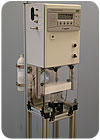A medical device manufacturer recently installed an in-line leak detection system into its catheter manufacturing operation.

Optinova AB is one of the world’s largest manufacturers of intravenous catheters. The 39-year-old company uses precision extruding equipment to mass-produce a wide variety of plastic tubing components. Production takes place in an ISO 14644-1 clean room environment.
Recently, Optinova installed an in-line leak detection system into its catheter tube manufacturing operation. The thin-wall tubing is used for nutrition and blood transfusion delivery systems.
Engineers were faced with the challenging task of developing a system to identify pinholes in the tubing while it was being formed. “In-line leak detection would reap huge benefits for us by eliminating secondary after-process testing,” says Roger Andersson, manager of development and engineering at Optinova.
Andersson and his colleagues contacted Adixen Scandinavia (a division of Alcatel Vacuum Technology), a leak detection firm based in Linkoping, Sweden. After meeting, both parties determined that tubes should be formed in a cloud of diluted hydrogen tracer gas. Then, the tube would pass through a specially designed accumulation chamber at line speed.
Minor defects, such as pinholes in the tube, would be identified by a detector that continuously monitors the chamber for the presence of hydrogen leaking from the tube into the chamber. A signal would be given from the detector to the tube manufacturing process if a leak was detected. The line would then be stopped and the faulty section cut and removed. The process would then continue.
An H2000 PLUS hydrogen leak detector was selected for the application. With a sensor that is specific to hydrogen, it has high leak rate sensitivity and requires no scheduled maintenance. According to Andersson, diluted hydrogen is an ideal tracer gas, because it is nonflammable, inexpensive, readily available and environmentally friendly.
A prototype system was delivered to Optinova’s 70,000-square-foot plant in Godby, Finland, and set up to run a few tests. “The test results showed that the system worked brilliantly,” recalls Andersson.
As a result, Adixen was contracted to build a final system based on the initial prototype findings. The new system was installed on one of the tube manufacturing lines and runs continuously. “Adixen did a great job,” claims Andersson. “Of all the equipment we have purchased in our plant, the tube leak tester required the least amount of adjustments.” Optinova has since invested in six more hydrogen leak testing systems-one for each of its tube production lines.
For more on hydrogen leak testers, visitwww.adixen-usa.comor call 978-430-2829.